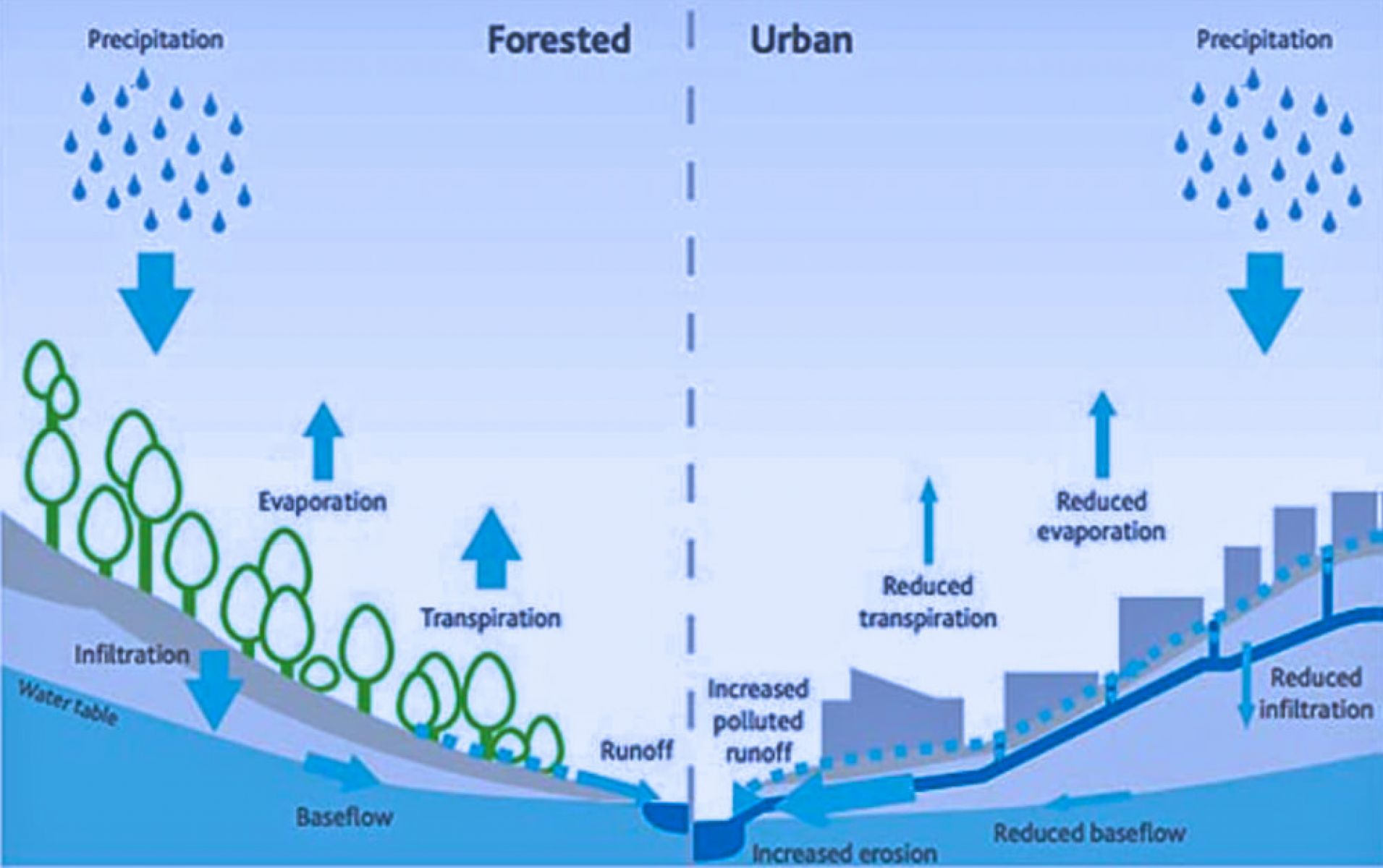On this page:
We will protect the health of our waterways and use stormwater as a resource to create greener, more liveable cities and towns.
This includes making it clearer who manages stormwater. Clearer responsibilities and better guidance will help reduce how much polluted stormwater flows into waterways.
Impact of urban development on the water cycle

Clarifying stormwater roles and responsibilities
In Melbourne, councils and Melbourne Water share responsibility for drainage and flood management. Since 1927, they have used the 60-hectare convention to split their responsibilities. This means that councils manage most smaller catchments and Melbourne Water manages the larger ones.
The 60-hectare convention rule was introduced almost 100 years ago. Since then, the types of assets and services used to manage stormwater have changed. This makes it difficult to apply the 60-hectare convention today. We have worked with Melbourne Water and the Municipal Association of Victoria (MAV) to review these arrangements.
The project partners have agreed in-principle on an improved 60-hectare model to split responsibilities. In some cases, the council and Melbourne Water may agree that a strict 60-hectare split is not the best approach. In these cases, they would assign responsibility to the most appropriate organisation.
Melbourne Water and the MAV are working with councils and other partners to implement this new approach. DEECA will support them as needed, including putting the new arrangements into policy or legislation.
Reducing stormwater flows
Currently, requirements in Victoria focus on reducing pollutants in stormwater. These include litter, sediment, nitrogen and phosphorus. But these pollutants are not the only harmful part of stormwater. Cities and towns have lots of hard surfaces that stop rainfall from soaking into the ground. So when it rains, lots of extra water enters waterways very quickly, harming the natural water balance.
In 2021, the EPA published new guidance to improve stormwater management in Victoria. This guidance will help the industry to reduce harm from stormwater flow volumes. It includes new stormwater flow reduction targets for Greater Melbourne.
We are looking at ways to support this guidance and meet these targets. This includes investigating whether we should include them in the Victoria Planning Provisions or other regulations.
Reviewing stormwater licensing
Stormwater is often treated as waste and quickly drained away. But, if we collect and reuse stormwater, we can reduce harm to waterways and increase our water supplies. To make this happen, we need to change how we think about stormwater and recognise its value.
Having clear rules for stormwater harvesting is important for this change.
In Victoria, the water entitlements framework regulates most water usage. Yet, most stormwater is not covered by this framework. This makes it difficult to supply to customers and secure access to stormwater for the environment, cultural and other uses. It also means we don’t know how much stormwater is being reused across Victoria and what impact that has on the environment.
To address these issues, we are reviewing stormwater licensing and responsibility for supplying stormwater to users. We are currently collaborating with water corporations and councils on this review.
Developing a stormwater offset framework
Under Victorian planning rules, many new developments need to treat stormwater to prevent pollution.
Sometimes you can do this on-site using rainwater tanks or rain gardens. But sometimes there isn’t enough space or there are other technical reasons why they won’t work.
In these cases, a better environmental outcome may come by treating stormwater offsite. For example, by using a larger treatment asset within the same catchment, like a man-made wetland.
Instead of treating all their stormwater on-site, developments can pay a stormwater offset fee to council. Then council can use these funds to build larger stormwater treatment assets. This way, the stormwater impact from the new development can be treated offsite. This is also known as a stormwater offset.
DEECA is developing an offsets framework to help councils that want to develop their own stormwater offsets scheme. This will make it easier for councils to set up and manage their own schemes and will include guidance on how to calculate offset fees.
Improving stormwater management advisory committee
In 2018, the Minister for Planning established the Improving Stormwater Management Advisory Committee to provide independent advice on planning and development controls for improving stormwater management and strengthening the links between water management and urban planning.
The committee spoke to people from a wide range of groups. This included councils, the housing and building industry, environmental groups, and government organisations.
The consultation showed strong support for improving the planning system. Specifically, improving how the system manages stormwater and encourages integrated water management.
Stormwater management reports
Based on the committee’s recommendations, planning reforms came into effect in October 2018.
These broadened the range of development types required to meet Victoria's stormwater planning requirements.
For more information
For information on how to meet Victoria’s stormwater planning requirements, visit stormwater management for urban development.
Page last updated: 08/09/23
